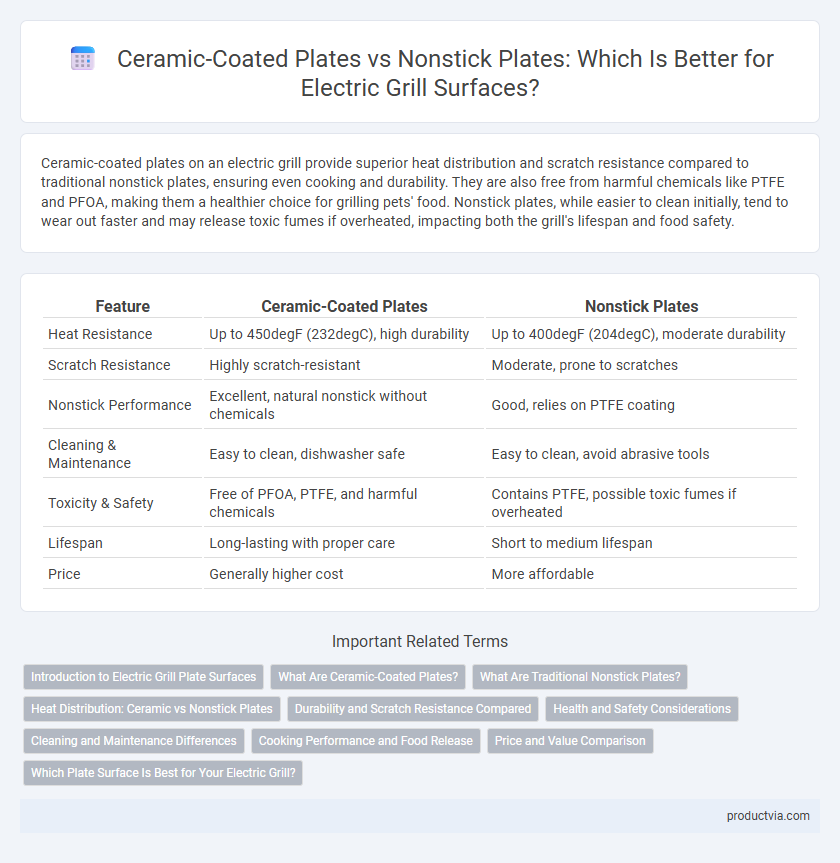Ceramic-coated plates on an electric grill provide superior heat distribution and scratch resistance compared to traditional nonstick plates, ensuring even cooking and durability. They are also free from harmful chemicals like PTFE and PFOA, making them a healthier choice for grilling pets' food. Nonstick plates, while easier to clean initially, tend to wear out faster and may release toxic fumes if overheated, impacting both the grill's lifespan and food safety.
Table of Comparison
| Feature | Ceramic-Coated Plates | Nonstick Plates |
|---|---|---|
| Heat Resistance | Up to 450degF (232degC), high durability | Up to 400degF (204degC), moderate durability |
| Scratch Resistance | Highly scratch-resistant | Moderate, prone to scratches |
| Nonstick Performance | Excellent, natural nonstick without chemicals | Good, relies on PTFE coating |
| Cleaning & Maintenance | Easy to clean, dishwasher safe | Easy to clean, avoid abrasive tools |
| Toxicity & Safety | Free of PFOA, PTFE, and harmful chemicals | Contains PTFE, possible toxic fumes if overheated |
| Lifespan | Long-lasting with proper care | Short to medium lifespan |
| Price | Generally higher cost | More affordable |
Introduction to Electric Grill Plate Surfaces
Ceramic-coated plates for electric grills offer enhanced heat retention and even cooking while providing a non-toxic, scratch-resistant surface that resists staining and can withstand higher temperatures. Nonstick plates, often coated with PTFE or similar materials, reduce food adhesion and simplify cleaning but may wear down faster and release harmful fumes at extreme heat. Choosing between ceramic-coated and traditional nonstick plates depends on desired durability, cooking performance, and maintenance preferences for electric grill use.
What Are Ceramic-Coated Plates?
Ceramic-coated plates on electric grills consist of a smooth, nonporous surface made from inorganic minerals that offer excellent heat distribution and scratch resistance. Unlike traditional nonstick plates coated with polytetrafluoroethylene (PTFE), ceramic coatings provide a chemical-free cooking surface that withstands higher temperatures without releasing harmful fumes. These plates are favored for their durability, ease of cleaning, and eco-friendly properties, enhancing overall grilling performance and food quality.
What Are Traditional Nonstick Plates?
Traditional nonstick plates for electric grills feature a synthetic polymer coating, typically polytetrafluoroethylene (PTFE), designed to prevent food from sticking during cooking. These plates offer easy cleanup and require less oil, making them popular for healthier grilling options. However, they may degrade over time due to high heat exposure and metal utensil use, which can affect their durability and performance.
Heat Distribution: Ceramic vs Nonstick Plates
Ceramic-coated plates provide superior heat distribution on electric grills due to their ability to retain and disperse heat evenly across the surface, preventing hot spots and ensuring consistent cooking. Nonstick plates, while offering easy food release, often have less uniform heat distribution, which can result in unevenly cooked meals. The enhanced thermal conductivity of ceramic coatings supports optimal grilling performance and energy efficiency.
Durability and Scratch Resistance Compared
Ceramic-coated plates in electric grills offer superior scratch resistance and maintain durability longer than standard nonstick plates, as the ceramic layer withstands higher temperatures and abrasive cleaning without degrading. Nonstick plates, typically made from Teflon or similar materials, are more prone to scratching and may lose their coating with regular use and metal utensil contact. Choosing ceramic-coated plates enhances the grill's lifespan and ensures consistent performance over time, especially under frequent or heavy-duty grilling conditions.
Health and Safety Considerations
Ceramic-coated plates on electric grills provide a non-toxic, PTFE- and PFOA-free cooking surface that emits fewer harmful fumes at high temperatures, enhancing overall health safety. Nonstick plates often contain chemical coatings that can degrade and release toxic substances when overheated, posing potential respiratory risks. Choosing ceramic-coated plates reduces exposure to hazardous compounds and supports safer grilling for frequent cooks.
Cleaning and Maintenance Differences
Ceramic-coated plates on electric grills provide a non-porous surface that resists food sticking and allows for easier cleaning with mild detergents, often requiring less scrubbing compared to nonstick plates. Nonstick plates, typically made from Teflon, can be more prone to scratching and may degrade faster under abrasive cleaning tools, necessitating gentle maintenance to preserve their coating. Both surfaces benefit from hand washing and avoiding metal utensils to extend their lifespan, but ceramic coatings tend to maintain their appearance and performance longer through routine care.
Cooking Performance and Food Release
Ceramic-coated plates on electric grills provide superior heat distribution and durability, ensuring even cooking and consistent grill marks. Nonstick plates excel in effortless food release, minimizing residue and simplifying cleanup, but may wear down faster under high heat. Ceramic coatings often resist scratching better and maintain cooking performance longer, making them ideal for users prioritizing longevity and consistent results.
Price and Value Comparison
Ceramic-coated plates for electric grills typically cost more upfront but offer superior durability and non-toxic cooking surfaces, providing long-term value by resisting scratches and high heat better than standard nonstick plates. Nonstick plates generally come at a lower price point, making them an affordable choice, but they may wear out faster and lose their effectiveness, potentially increasing replacement costs over time. Considering both price and longevity, ceramic-coated plates often deliver greater overall value despite the higher initial investment.
Which Plate Surface Is Best for Your Electric Grill?
Ceramic-coated plates provide superior heat distribution and heightened durability, making them ideal for even cooking and easy cleaning on electric grills. Nonstick plates offer excellent food release properties but may wear down faster and require gentler care to maintain their coating. Choosing between ceramic-coated and nonstick plates depends on your cooking preferences, maintenance willingness, and desired longevity of the grill surface.
Ceramic-coated plates vs nonstick plates for electric grill surface Infographic

 productvia.com
productvia.com